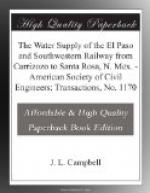KENNETH ALLEN, M. AM. SOC. C.E. (by letter).—From its lightness, toughness, flexibility, and the facility with which it can be laid, wood pipe has manifest advantages for use in inaccessible places and where handling is difficult; loss in transportation is almost negligible, it will stand much unequal settlement without cracking, and ordinary leaks are easily repaired.
The coating of the bands is of such great importance that it should be inspected very thoroughly, in order to remedy defects before the back-filling is done. The writer has found Durable Metal Coating an excellent preservative. Bands coated with this preparation were buried in a salt marsh, and, after a year, the metal was found intact and the coating fresh and elastic. This coating, however, does not adhere very firmly to a smooth metal surface, so that, with careless handling, patches may become rubbed or torn off.
There is no advantage in coating the surface of the pipe. To prevent decay, such pipe should carry water under pressure or be laid in a saturated soil, so that the wood of which it is made will always be saturated, and coating the wood may interfere with this. Under these conditions the life of such pipe is not known, but it is evidently very great. Large quantities of wood pipe have been removed from trenches in Boston, New York City. Philadelphia, Baltimore, and elsewhere, usually in perfectly sound condition. It was commonly made of logs of spruce, yellow pine, or oak, from 12 to 18 ft. long, 12 to 24 in. in diameter, and with a bore from 3 to 6 in. in diameter. Some 6-in. pipe taken up in Philadelphia had an external diameter of 30 in. The ends were usually bound with wrought-iron collars, and adjacent lengths were connected by an iron thimble driven into the end of each piece.
A few years ago the writer took up more than 2000 ft. of wood pipe of this kind, which had been laid in saturated soil about a century earlier. It was of Southern pine logs, about 16 in. in diameter, 14-1/2 ft. long, and had a 5-in. bore. Joints were made with tapering cast-iron ferrules 9 in. long, and connections to smaller service pipes were made with similar but smaller ferrules of cast brass. The wood was apparently as sound as when it was first laid.
The use of flat iron for wrapping or banding pipe is believed to be wrong in principle. Round iron furnishes the requisite strength with the least exposure to corrosion, and ensures a more perfect contact with the wood.
In a 42-in. stave pipe laid by the writer for the Water Department of Atlantic City, N.J., the lumber used was Washington fir, cypress having been found difficult to procure in sufficient quantity, and redwood being more costly and no better. In this, his experience coincided with that of the author. Cedar was considered, but could not be obtained in sufficient lengths or quantity, and long-leaf pine which would have passed the somewhat rigid specifications would have been difficult to secure. It is believed, however, that there is a field at least for long-leaf pine for such construction. Washington fir was found admirable in every respect, and was moderate in cost at that time.




